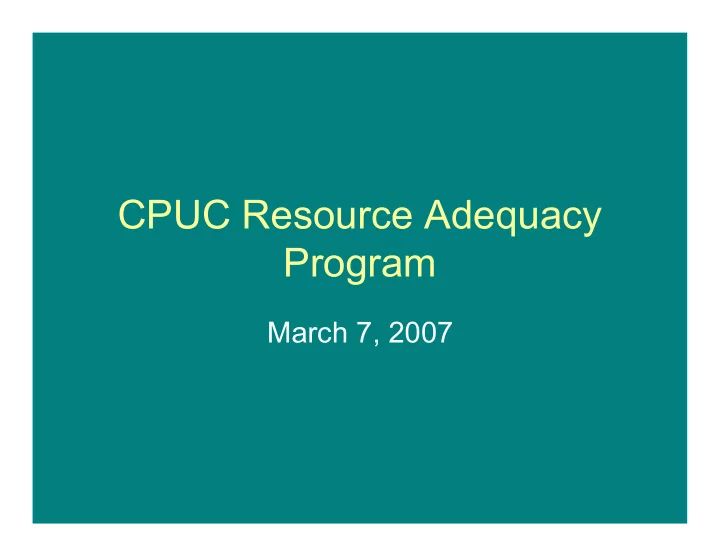

CPUC Resource Adequacy Program March 7, 2007
Public Utilities Code Section 380 • (a) The commission, in consultation with the Independent System Operator, shall establish resource adequacy requirements for all load-serving entities. • (b) …objectives: (1) Facilitate development of new generating capacity and retention of existing generating capacity that is economic and needed. (2) Equitably allocate the cost of generating capacity and prevent the shifting of costs between customer classes. (3) Minimize enforcement requirements and costs. • (h) The commission shall determine and authorize the most efficient and equitable means of achieving…the objectives…
CPUC Jurisdiction • The CPUC regulates privately owned electric companies operating in California. • Currently there are 3 major Investor Owned Utilities and 12 Energy Service providers operating in the CAISO control area • CPUC regulated entities represent about 90% of the CAISO peak load and energy use.
Procedural History • Rulemaking 04-04-003 – D.04-10-035 established policy framework and developed initial rules for counting generation capacity – D.05-10-042 established System Resource Adequacy program including summer ahead (year-ahead) filings and monthly filings • Rulemaking 05-12-013 – D.06-06-064 established the Local Resource Adequacy program – D.06-07-031 resolved implementation issues including defining a tradable capacity product
Resource Adequacy Requirement (RAR) • RAR is calculated using an LSE’s forecast load by month, plus a reserve margin of 15%, for a total of 115% of forecast load. • LSE forecast load is based on a 1 in 2 year and baselined against the CEC forecast. • LSEs file their forecast load and the CEC performs an plausibility adjustment.
What is the Resource Adequacy Obligation • Contractual Obligation on Suppliers to: – Be scheduled by the LSE – Bid into day-ahead market if not scheduled – Be subject to CAISO Residual Unit Commitment process – Be available to real-time to the extent able
What counts toward RAR • RAR is a capacity requirement, not energy. Units must be in the CAISO database. • Imports based on an allocation of import capacity. • Dispatchable Demand Response programs and if paid by the public use charge are allocated to all LSEs • RMR units under condition 2 are allocated to LSEs paying the RMR charges. • LD contracts are being phased out. • DWR contracts count for their life. • Intermittent (e.g. Wind) and energy limited resources using PUC adopted counting rules.
System Resource Adequacy Implementation • Showing for June-Sept 2006 filed Feb 2006 (year–ahead) • Showing for May-Sept 2007 filed Nov 2006 (year–ahead and local) • Year-ahead system showing is 90% of RAR, or 103% of an LSEs forecast load. • Monthly showing 100% of RAR due 1 month ahead (June showing due May 1)
RA Summer 2006 June July August Sept Forecast 35,589 39,546 42,802 38,063 Load DR 1,862 2,009 2,027 2,013 RAR 38,786 43,168 46,891 41,458 RA 46,918 48,111 48,355 46,760 Resources RA as % of 136% 126% 118% 128% Load
RA Summer 2007 June July August Sept Forecast 36,817 41,034 44,618 39,229 Load DR 2,141 2,225 2,226 2,228 RAR 39,877 44,630 48,751 42,551 RA 47,571 47,289 47,236 46,414 Resources RA as % of 129% 115% 106% 118% load
Local Resource Adequacy • CAISO performed a Local Capacity Technical Analysis (also called the LCR study) that identified 9 local areas that require in-area generation to meet peak loads. • Study is performed on a 1 in 10 forecast basis • Study provided Commission with 2 reliability options
Local RAR Implementation • Decision 06-06-064 adopted Local RAR • LSEs must procure resources in 4 Local areas: LA Basin, San Diego, SF Bay Area, Other PG&E areas (combination of 6 local areas identified in CAISO study) • CAISO publishes a list of the qualifying capacity (generation units) located in each local area. • LSEs Local RAR based on load shares in the IOUs service territories • Reliability level for 2007 set at Category C (N-1-1/N-2) level recommended by CAISO • Local RAR filing for 2007 Nov 2, 2006-no monthly filings
Rulemaking 05-12-013, Phase 2 Track 1 – Track 1 – June Decision Ex June Decision Expected pected • Local RA Requirements – CAISO 2008 LCR • Probabilistic LCR Assessment linked to Grid Planning Process • Zonal RA Requirements • Demand Response program • Coordination of RA with CEC load forecasting • Coordination of RA and Backstop mechanism • Implementation of AB 1969 • Minor Implementation Topics
Track 1 Schedule • 1/26/07 Proposals filed • 2/2/07 CPUC Report on 2006 • 2/8, 2/20, 2/21, 3/8 Workshops • 3/9 CAISO issues Final 2008 LCR • By 3/20 meeting on LCR • 3/22 Proposal from Workshops • 3/23 motions for hearings • 4/6 Comments on all Issues • 4/20 Reply comments • 5/22 Proposed Decision • 6/11 Comments on Proposed Decision • 6/21 Final Decision
TRACK TRACK 2: 2: Long-Term Long-Term RA RA Program Program Issues Issues • Centralized capacity market, bilateral trading, and alternative market design • Registration/tagging for RA capacity • Multi-year forward commitment time horizons • LSE opt-out from cost allocation mechanism (D.06-07-029) • Coordination of RA program with MRTU as necessary • Procurement obligations for resource mix and ancillary services • Market power mitigation • Planning Reserve Margin
Track 2 Schedule • 3/30 Proposals Filed • 5/18 Pre-Workshop Comments • 7/13 Reply Comments • 8/15-31 Workshops • 9/26 Staff Report • 10/19 Comments on Staff Report • 11/9 Reply Comments on Staff Report • 12/8 Proposed Decision • 1/7 Comments on Proposed Decision • 1/17 Final Decision
Recommend
More recommend